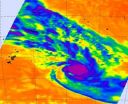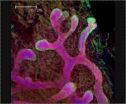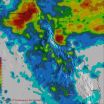(Press-News.org) PHILADELPHIA – The molecular pathway that carries time-of-day signals from the body's internal clock to ultimately guide daily behavior is like a black box, says Amita Sehgal, PhD, the John Herr Musser Professor of Neuroscience and Co-Director, Comprehensive Neuroscience Center, at the Perelman School of Medicine, University of Pennsylvania.
Now, new research from the Sehgal lab is taking a peek inside, describing a molecular pathway and its inner parts that connect the well-known clock neurons to cells governing rhythms of rest and activity in fruit flies. Sehgal is also an investigator with the Howard Hughes Medical Institute.
The other co-author on the study is Wenyu Luo, PhD, a Penn doctoral student who recently defended her dissertation. The findings, which will be featured on the cover of the February 17th issue of Cell, are published online this week.
"Most colleagues would say that we have some understanding of how the clock works and how it is synchronized with light," says Sehgal. "But we are just beginning to get a glimpse of how the clock drives behavior in the rest of an organism's systems."
Prying the Black Box Open
Normally, flies have a robust rhythm of being active during daylight hours and quiet during the night. Sehgal and Luo essentially found that a microRNA (miRNA) named miR-279 acts through the JAK/STAT pathway to regulate locomotor activity rhythms through a daily cycling of proteins.
An miRNA is a tiny piece of RNA - a little over 20 bases (DNA building blocks) in length -- that binds to matching pieces of messenger RNA, thereby tying it up and decreasing the production of the corresponding protein.
They found that in mutant flies in which miR-279 was either overexpressed or deleted -- causing high levels or low levels of JAK/STAT signaling -- the flies wake and sleep at random intervals. The flies showed no discernible pattern of activity. Therefore, the investigators concluded that a mid-range level of JAK/STAT activity is necessary to maintain the flies' normal pattern. In fact, they found that STAT activity displays a daily rhythm.
Part of the Clock Circuitry
Oscillations of the clock protein PERIOD are normal in clock pacemaker neurons lacking miR-279, suggesting that miR-279 acts downstream of the clock neurons. The team identified the JAK/STAT partner, a protein called Upd, as a target of miR-279. They also showed that knocking down Upd rescues the off-rhythm behavior of the miR-279 mutant flies.
In addition, in brains of mutant flies stained to identify circadian proteins, they found that the central clock neurons project their axons into the vicinity of Upd-expressing neurons, providing a possible physical connection by which the central clock could regulate JAK/STAT signaling to control rest and activity rhythms.
With these findings, the team proposed a model in which the central clock affects the cycle of secretion of the Upd protein from cells. "Upd may act like a time-release capsule," explains Sehgal. "To maintain a typical rest:activity rhythm, the level of Upd has to be just right."
The mRNA levels of Upd in neurons are kept low by miR-279. Upd may rhythmically activate a receptor, Dome, in a third cell, which would lead to daily oscillations of JAK/STAT activity and ultimately to the rest:activity rhythm.
The direct clinical implications of knowing the players in this complicated pathway are not yet clear. But we might be able to conclude, suggests Sehgal, that, if these mechanisms are conserved in humans, then disorders in which the JAK-STAT pathway isn't working properly, as in some immune disorders, physicians might also see problems with patients' sleep-wake cycle.
These findings also provide researchers with a handle on the neural circuit that generates rest:activity behavior in Drosophila. The ultimate goal of many neurobiologists is to trace the entire molecular and cellular pathway that produces a specific behavior. This study is a step towards that goal.
INFORMATION:
The work was supported by NIH grants 1-R560NS-048471 and 2R01NS04847.
Penn Medicine is one of the world's leading academic medical centers, dedicated to the related missions of medical education, biomedical research, and excellence in patient care. Penn Medicine consists of the Raymond and Ruth Perelman School of Medicine at the University of Pennsylvania (founded in 1765 as the nation's first medical school) and the University of Pennsylvania Health System, which together form a $4 billion enterprise.
Penn's Perelman School of Medicine is currently ranked #2 in U.S. News & World Report's survey of research-oriented medical schools and among the top 10 schools for primary care. The School is consistently among the nation's top recipients of funding from the National Institutes of Health, with $507.6 million awarded in the 2010 fiscal year.
The University of Pennsylvania Health System's patient care facilities include: The Hospital of the University of Pennsylvania -- recognized as one of the nation's top 10 hospitals by U.S. News & World Report; Penn Presbyterian Medical Center; and Pennsylvania Hospital – the nation's first hospital, founded in 1751. Penn Medicine also includes additional patient care facilities and services throughout the Philadelphia region.
Penn Medicine is committed to improving lives and health through a variety of community-based programs and activities. In fiscal year 2010, Penn Medicine provided $788 million to benefit our community.
Molecular path from internal clock to cells controlling rest and activity
2012-02-08
ELSE PRESS RELEASES FROM THIS DATE:
How early breast tumors become deadly: A small group of molecules might hold the answer
2012-02-08
Some early-stage breast cancers are potentially harmless, but others invade surrounding healthy tissue and become deadly.
This study has identified a small pattern of molecules that highlights important differences between early-stage breast tumors and invasive, deadly ones.
The findings might lead to a way to identify early tumors that will likely become invasive.
COLUMBUS, Ohio – Researchers have discovered a restricted pattern of molecules that differentiate early-stage breast tumors from invasive, life-threatening cancer. They also found a similar molecular signature ...
NASA satellite sees tropical storm Cyril a strong, compact storm
2012-02-08
Tropical Storm Cyril was known as "11P" has been strengthening since February 6, and still appears very compact on infrared NASA satellite data.
In the morning hours of February 7 (local time Vanuatu) Cyril was located south of the island of Vavau in the Kingdom of Tonga. All warnings for Niue and Tonga have now been cancelled.
During the morning hours of February 7, Cyril picked up speed and is moving to the southeast at 28 knots (~32 mph/~52 kph). Cyril's maximum sustained winds were near 45 knots (~52 mph/~83 kph). Those tropical-storm-force winds only extended out ...
44 percent of postmenopausal women with distal radius fracture have low levels of vitamin D
2012-02-08
SAN FRANCISCO – Wrist fractures, also called distal radius fractures (DRF), are among the most common osteoporosis-related fractures occurring on average 15 years earlier than hip fractures. As vitamin D deficiency has recently been linked with muscle weakness, increased fall risks, and bone fractures, investigators sought to determine the prevalence of vitamin D deficiency among post menopausal women with DRF. The study, "Hypovitaminosis D in Postmenopausal Women with a Distal Radius Fracture," was presented today at the 2012 Annual Meeting of the American Academy of ...
NASA sees cyclone Jasmine's power and new eye
2012-02-08
Cyclone Jasmine continues to wind between New Caledonia and Vanuatu and bring cyclone-force winds, heavy rain and very rough surf. NASA's Aqua satellite passed overhead early on February 7 and noticed the strongest part of the cyclone was around the center and north and east of the center. Aqua data showed that an eye has developed.
The Atmospheric Infrared Sounder (AIRS) instrument on NASA's Aqua satellite captured an infrared image of Jasmine on February 7, 2012 at 03:17 UTC (2:17 p.m., Pacific/Noumea local time/Feb 6, 10:17 p.m. EST). Jasmine's strongest thunderstorms ...
Nicaragua, Central America's Top Economy in 2011
2012-02-08
The Central Bank of Nicaragua (BCN, for its acronym in Spanish), in a recently published report, stated that the country's gross domestic product (GDP) increased by 4.7 percent in 2011, the highest growth rate in the Central American region and well above the Latin America and the Caribbean average of 4.3 percent.
Following Nicaragua's growth in 2011 were Costa Rica with a 3.8 percent GDP growth, Guatemala with 3.3 percent, Honduras with 3.2 percent and El Salvador with 1.4 percent. This is the second consecutive year in which Nicaragua leads the region in terms of ...
Rothman at Jefferson researchers find epidural steroid injections do not benefit spine patients
2012-02-08
(PHILADELPHIA) – Researchers at the Rothman Institute at Jefferson examined data on patients being treated for lumbar stenosis and the degenerative spine condition spondylolisthesis and found that patients who received epidural steroid injections (ESI) had a higher rate of crossover to surgery and fared worse in physical health and bodily pain versus those who did not receive ESI, dispelling their pre-study hypothesis.
Data for this study was gathered from the database of the prospective, multicenter NIH-funded SPORT (Spine Patient Outcomes Research Trial) of surgical ...
Salk scientists use an old theory to discover new targets in the fight against breast cancer
2012-02-08
La Jolla, CA -- Reviving a theory first proposed in the late 1800s that the development of organs in the normal embryo and the development of cancers are related, scientists at the Salk Institute for Biological Studies have studied organ development in mice to unravel how breast cancers, and perhaps other cancers, develop in people. Their findings provide new ways to predict and personalize the diagnosis and treatment of cancer.
In a paper published February 3 in Cell Stem Cell, the scientists report striking similarities between genetic signatures found in certain types ...
HostGator Partners with Website Builder BaseKit
2012-02-08
BaseKit, the online website builder, has been launched by HostGator; enabling their SMB's to build and manage their own website with the state of the art technology. The hosting giant, based in Houston, Texas, is offering BaseKit to both new and existing customers.
As one of the fastest growing private companies in America, HostGator is always seeking innovative products and services to enrich its customers' experiences and surpass their expectations. BaseKit has received international acclaim as an all-in-one website builder that lets SMB's build a site that "looks ...
NASA's TRMM satellite measures flooding rains from Australia monsoon
2012-02-08
A monsoon trough continues to drench northeastern Australia and NASA's Tropical Rainfall Measuring Mission (TRMM) satellite measured and calculated the rainfall in the region.
Low pressure centers associated with a summer monsoon trough have repeatedly drenched Australia from central Queensland to northern New South Wales. The clockwise rotation of these low pressure centers have continued to pump warm moist air from the Coral Sea over these areas resulting in severe flooding. Thousands of Australians have been displaced by this flooding.
A Tropical cyclone called Jasmine ...
Latest Tracker I-9 Software Update Ensures Easier E-Verify Compliance, Adds Online Training, and Enhances Form I-9 Reporting Tools
2012-02-08
Tracker Corp, http://trackercorp.com, the most innovative developer of Form I-9 & E-Verify compliance software and the immigration case management system trusted by more Fortune 500 employers than any other provider, released the latest round of enhancements to its Tracker I-9 software, version 7.4.
Tracker I-9 software fully complies with all current functional changes to E-Verify (v23). These changes include enabling RIDE (Records and Images from DMV for E-Verify) validation of certain Drivers' Permits and State-Issued ID cards (currently Mississippi only), providing ...





